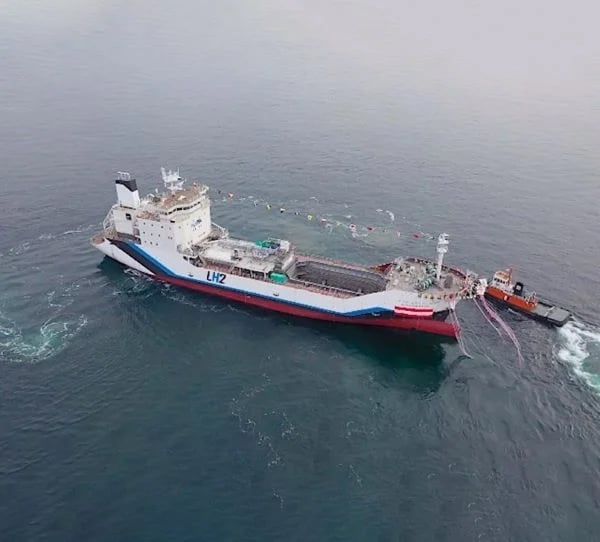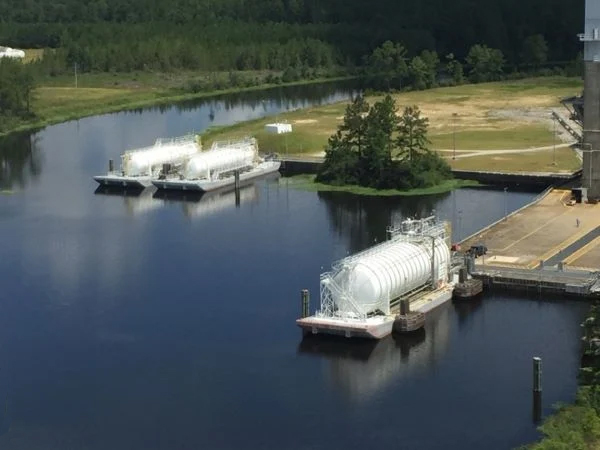The world is rapidly decarbonising; the process is happening a lot quicker than previously envisaged. So, it is quite likely we will see members of SIGTTO (The Society of International Tanker and Terminal Operators) in the near future carrying non-hydrocarbon gases in bulk such as liquid hydrogen (LH2) and carbon dioxide (CO2) as cargo onboard purpose‑built vessels.
We therefore noted with great interest the launch of the world’s first ever liquid hydrogen tanker just before Christmas 2019 in Kobe, Japan.
The Suiso Frontier is designed to transport liquefied hydrogen (Suiso being the Japanese for hydrogen). The LH2 cargo is cooled to –253°C; at this temperature, hydrogen is at atmospheric pressure and occupies just 1/800 of its original vapour volume. Suiso Frontier has one, 1250m3 vacuum-insulated, Type C storage tank and is on schedule for delivery in late 2020. Once operational, Suiso Frontier will transport LH2 from Australia to Japan.

Suiso Frontier on launch day [pictured above].
For this trade, the hydrogen will be produced by a prototype brown coal gasification facility at Port of Hastings in Victoria, South Australia. The LH2 receiving terminal is being built near Osaka in Kobe Prefecture, and the project is to prove the feasibility of bulk LH2 shipping by sea.
When burned, hydrogen releases energy and produces only water – and no greenhouse gases. This makes it a very climate-change-friendly fuel.
From the environmental perspective, LH2 is classified according to the production method. Brown coal gasification clearly involves fossil fuels, though in this case the Australian plant is being constructed with “carbon capture” and storage underground offshore. So, this cargo is referred to as “blue hydrogen”. “Grey hydrogen” is produced directly from hydrocarbons but without carbon capture. Production involves using electrolysis by a renewable source of energy and therefore does not involve fossil fuels or greenhouse gas emissions. Green hydrogen is clearly a long‑term solution option for decarbonisation.
In the USA, NASA has used hydrogen as fuel for the space shuttle and other rockets for many years. NASA has three barges – pictured below – to carry bulk LH2 between its facilities on the inland waterways of Louisiana, Mississippi and Florida. It is understood that on at least one occasion, a NASA barge fully-loaded with LH2 was towed from the US Gulf to the European rocket launch facility in French Guyana.

The NASA Liquid Hydrogen Barge fleet [pictured above].
As LH2 had never before been envisaged as a regular bulk cargo to be carried at sea, hydrogen was not included in IMO’s IGC code. When the Suiso Frontier trade was planned, SIGTTO played an integral part with the class societies in drawing up the Interim guidelines for the carriage of liquid hydrogen in bulk; this was attached to the IGC Code and agreed at MSC 97, being formally adopted by IMO on 25th November 2016.
There are many challenges to carrying liquid hydrogen at sea, not least the extremely low temperature at atmospheric pressure, the unusually high upper explosive level, the extended flammable range and the very small molecular size. The extreme cryogenic carriage temperature of –253°C for LH2 at atmospheric temperatures presents unique challenges; after all, the cargo is only 20°C above the absolute zero of temperature (also known as “zero degrees Kelvin” and written as “0K”).
Many of these challenges are not experienced even when carrying LNG at -160°C. For example, onboard LNG carriers, nitrogen is used in spaces around the cargo containment system such as barrier or annular spaces. It is not possible to use nitrogen in such places on an LH2 carrier, as nitrogen becomes liquid at -196°C at atmospheric pressure so it would condense if in contact with a surface at LH2 temperature. Likewise, oxygen has a boiling point of -192°C and liquid oxygen could form if oxygen (or air) came into contact with LH2 containment. Helium is the only practical gas for inerting LH2 system; unfortunately, this is a very expensive product, and would be very challenging to produce onboard, if possible at all.
Fortunately, there are several grades of austenitic stainless steels that are suitable for extremely low cargo temperatures. However, the hydrogen atom is the smallest of all the elements, and the molecular form (H2) also has an extremely small size compared to more common gases such as methane. So LH2 has a very high permeability compared to LNG, which means hydrogen can leak more easily through the tiniest of cracks or gaps; this is a classic example of Graham’s Law of Diffusion. Weld metal surfaces can also potentially suffer hydrogen embrittlement in LH2 service.
Hydrogen has a very wide flammable range of 4% to 75% gas-in-air; this compares to 5-15% gas-in-air for LNG. Furthermore, the extremely low minimum ignition energy of hydrogen gas/air mixtures of 0.017mJ (compared to 0.274mJ for methane) creates additional challenges for leak prevention, leak detection and ignition protection. For example, a different standard is required for “certified safe” electrical equipment on LH2 carriers – both fixed and portable. In addition, in the event of a cargo fire, the low luminosity of visibility of a hydrogen flame can cause problems for fire detection. The high flame velocity can lead to detonation and an associated shockwave.
In order to manage boil off onboard Suiso Frontier, the Type C cargo tank provides significant “pressure containment” capability due to the higher operating pressure. In addition, a Gas Combustion Unit (GCU) is fitted to deal with excess boil-off.
In principle, the boil-off management options are similar to an LNG vessel. One option for future designs is to use the hydrogen boil off gas as main engine fuel. However, this is not included in the design of Suiso Frontier.
The design, construction and operation of any pioneering prototype ship such as Suiso Frontier calls for a comprehensive risk assessment and the incorporation of suitable risk mitigation measures – in close association with classification societies, who can bring unique experience to the table. Ships like this will be designed using a major hazard risk management tool such as “Bow Tie”.
Once delivered, SIGTTO will be monitoring the operation of Suiso Frontier, seeking to learn as much as possible for future guidelines for the safe carriage of this absolutely unique cargo – both for members and for the shipping industry at large. One of SIGTTO’s key roles is to develop “Best Practice” for stakeholders in this fast developing “Suiso” energy frontier.







